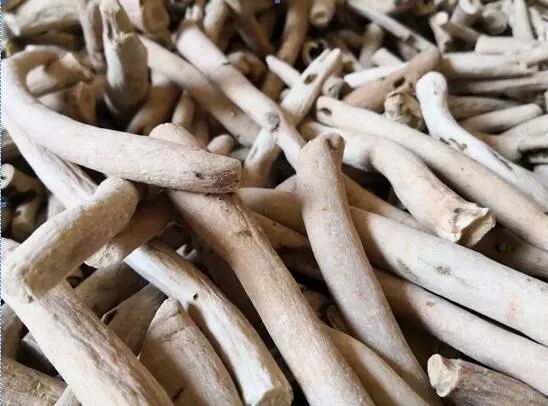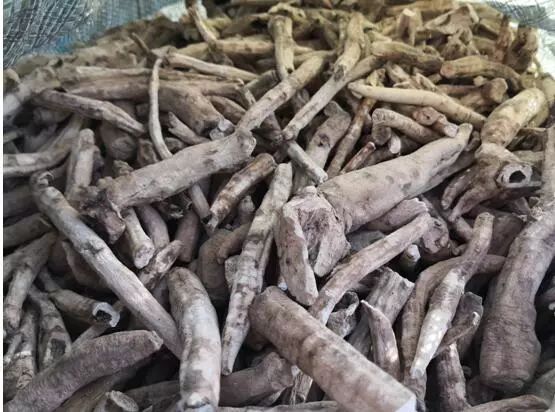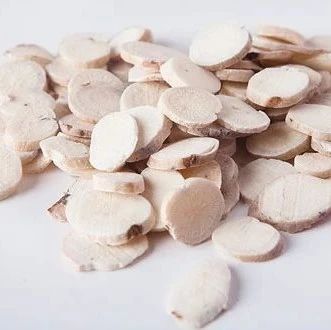Author: Yue Xia Du Zhuo Source: Dandelion
Bai Shao:
I want to showcase my pure white essence,
Please gently remove my delicate outer garment……
—— The standard for the medicinal material “Bai Shao” should continue to “respect the ancients” or moderately “follow the present”.
Bai Shao (Paeonia lactiflora) has extremely high medicinal value and is one of the most commonly used varieties in Traditional Chinese Medicine (TCM).
Since ancient times, the confusion and distinction between Bai Shao and Chi Shao have been a topic of debate, from differing opinions in ancient medical texts to modern disputes that continue to this day. Because their medicinal components are essentially the same, ancient texts referred to the white-flowered variety as “Bai Shao” and the red-flowered variety as “Chi Shao”. Some modern interpretations even suggest that the name Bai Shao comes from its appearance after being boiled in water, where it becomes “white as jade”, thus collectively referred to as “Bai Shao”.
—— In fact, this is all nonsense. Regardless of whether the flowers are white or red, Bai Shao is Bai Shao, and Chi Shao is Chi Shao! They are two “sister” medicinal materials with the same origin. Bai Shao is cultivated in many places, while Chi Shao grows wild. Upon close observation, Bai Shao roots are generally plump and robust, with a delicate skin and a white powdery surface; Chi Shao roots tend to be slender, with rough skin and an intermingled red and white interior.
Additionally, Bai Shao and Chi Shao have different pharmacological effects; Bai Shao is known for its ability to “nourish and protect”, while Chi Shao is effective for “promoting blood circulation and dispelling stasis”. Hence, there is a saying: “Bai nourishes while Chi purges, Bai protects while Chi disperses”.
If these distinctions are not understood, the spread of misinformation in rural areas is regrettable, but if doctors also become confused, how will patients fare?
Based on this, for me, in my series discussing the standards for medicinal materials, I wish to focus on my hometown’s Bai Shao as a key variety!

Figure 1: Bai Shao after being boiled in water and peeled
In recent years, with the increasing strictness of regulations in the TCM field by relevant national departments, Bai Shao has frequently appeared on the “blacklist” due to issues such as sulfur, characteristics, extractives, and heavy metals not meeting pharmacopoeia requirements. The main focus of non-compliance has often been the difficulty in achieving the required content of paeoniflorin (C23H28O11) of no less than 1.6% as per pharmacopoeia standards.
So, what are the reasons for the insufficient content of paeoniflorin in Bai Shao?
Generally speaking, factors such as short growth duration, improper harvesting timing, sulfur fumigation, production in non-standard regions, initial processing methods like boiling in water, drying conditions, and poor storage and transportation management are all related to the difficulty in meeting national pharmacopoeia standards for Bai Shao.
Of course, the pharmacopoeia’s slightly higher requirements for the content of Bai Shao compared to actual conditions should also be acknowledged as one of the reasons for non-compliance!
In the past two years, issues with Bai Shao’s non-compliance due to sulfur fumigation and improper harvesting timing have seen significant improvements as local farmers have increasingly recognized the importance of “improving the quality of medicinal materials”.
However, in terms of initial processing, the method of “boiling in water” for Bai Shao and the resulting loss of paeoniflorin content remains a major headache for this variety. Additionally, some peeling facilities prioritize profit over quality, leading to practices that compromise the boiling temperature, timing, and drying conditions, further exacerbating the challenges in meeting pharmacopoeia standards for paeoniflorin content.
Currently, to meet pharmacopoeia requirements and improve the content of paeoniflorin, there have been corresponding “innovations” in the market, with some unpeeled “black and white Bai Shao” or “raw peeled Bai Shao” starting to circulate in the industry.
In this regard, some “well-known experts” in the industry, due to their superficial understanding of Bai Shao’s intrinsic qualities, have praised these “innovative phenomena”, and some articles in industry publications have incorrectly promoted them, leading to misleading information.
Indeed, the emergence of unpeeled or raw peeled “black and white Bai Shao” and “raw peeled Bai Shao” as “innovative products” in recent years has helped improve the content of paeoniflorin in Bai Shao.
However, Bai Shao is Bai Shao! It is not “black Bai Shao”. The reason is not that the ancients’ practice of “boiling in water and peeling” is “superfluous” or “mysterious”; rather, it is deeply connected to relevant medical knowledge, properties, meridian pathways, and pharmacological effects. This practice is one of the effective methods developed over thousands of years by our predecessors in the field of TCM to “eliminate minor toxins and dispel cold”.

Figure 2: Unpeeled “black and white Bai Shao” dried in the sun
Bai Shao is a cold and cool herb, with a bitter, sour, and slightly toxic nature; it enters the liver and spleen meridians. Its main effects are to soothe the liver, regulate qi, nourish blood, and astringe yin, commonly used for symptoms of blood deficiency and jaundice. It is especially effective for women’s menstrual irregularities, excessive bleeding, and leukorrhea.
From the above description, we can see why ancient physicians advocated for “boiling in water and peeling” during the harvesting and initial processing of Bai Shao. This is because Bai Shao’s “cold nature” conflicts with its therapeutic targets of “nourishing blood and astringing yin”. The practice of “boiling in water and peeling” is the first step in alleviating this contradiction.
Thus, in the field of TCM, Bai Shao has been recorded since the “Shennong Bencao Jing” and was first mentioned with the peeling method in the “Jin Kui Yao Lue” before the Sui and Tang dynasties. The first detailed description of processing appeared in the first monograph on processing in Chinese pharmacology, the “Lei Gong Pao Jiao Lun”: “After harvesting, dry in the sun at noon, scrape off the rough skin with a bamboo knife, mix with honey and steam, then dry for use…” This shows that with the passage of time, the standards for the initial processing of Bai Shao have evolved from simple to refined.
Later, the Song dynasty texts such as “Pu Ben Shi Fang” and “Tai Ping Sheng Hui Fang” described more complex boiling methods: “After harvesting, scrape off the skin and boil in running water until it boils a hundred times, then dry in the shade…” This has already exceeded the current requirements of the “Chinese Pharmacopoeia” for Bai Shao, which states: “Boil in water and remove the outer skin or peel before boiling, then dry in the sun”.
As for the Yuan, Ming, and Qing dynasties, the processing methods became even more stringent, including “washing, peeling, soaking in wine, roasting with wine, moistening with wine, and washing with wine…” to an astonishing level.
Additionally, classic formulas such as “Xiao Jian Zhong Tang”, “Si Wu Tang”, “San Bai Tang”, “Jian Pi Yin”, and “Shao Yao Gan Cao Tang” from many ancient medical texts confirm that the Bai Shao used in these formulas is always the “stir-fried Bai Shao” or “Bai Shao” that has been boiled and peeled, not the so-called unpeeled, raw peeled “black and white Bai Shao” or “raw peeled Bai Shao”.
This includes the efforts of our predecessors in the field of TCM throughout history to enhance or change the properties and uses of Bai Shao, following processing methods such as wine-mixed Bai Shao, vinegar-fried Bai Shao, dry-fried Bai Shao, bran-fried Bai Shao, earth-fried Bai Shao, honey-steamed Bai Shao, ginger-prepared Bai Shao, and charred Bai Shao… etc. The premise and orientation of these processing methods are clear; they all start with “taming its nature” and then “preserving its efficacy” to achieve the goal of “significantly enhancing therapeutic effects”.

Figure3: Raw peeled “raw Bai Shao” not boiled
Although in the current “Chinese Pharmacopoeia”, the descriptions of Bai Shao raw materials, Bai Shao slices, stir-fried Bai Shao, and wine-prepared Bai Shao are all the same, general and singular, without detailed differentiation, in the hands of ancient masters, their therapeutic targets have long been refined into different categories. For example:
Wine-prepared Bai Shao is better for nourishing blood and softening the liver, alleviating pain…
Stir-fried Bai Shao is beneficial for soothing the liver, regulating qi, and nourishing blood to regulate menstruation…
Vinegar-prepared Bai Shao is often used for astringing the liver, stopping pain, and relieving depression…
Earth-fried Bai Shao tends to strengthen the spleen and stomach, alleviating pain… etc.
In this regard, similarly, the ancients not only advocated for “boiling in water and peeling” during the harvesting of Bai Shao to eliminate its bitter and cold toxicity but also continuously researched processing methods such as “wine-frying and vinegar-preparing” to enhance its intrinsic quality. They often combined Bai Shao with Gui Zhi (Cinnamon Twig), Chuan Xiong (Szechuan Lovage), and Gan Cao (Licorice) in prescriptions, aiming to use these herbs to eliminate the adverse effects of Bai Shao’s “bitter, sour, cold, and toxic” properties, achieving the goal of “clarifying turbidity and balancing the rise and fall”.
Thus, returning to the original topic, if I have clearly explained why Bai Shao must be the “boiled and peeled Bai Shao” and cannot be the unpeeled “black and white Bai Shao” or “raw peeled Bai Shao”, and if everyone understands this clearly, then what do you think: is it more important to meet the national pharmacopoeia’s content standards by using “unpeeled, raw peeled black and white Bai Shao” or to preserve the processing achievements gained through the hard work of our ancestors over thousands of years through practical experience?
I believe the answer is already clear to everyone, just as it is to me! Naturally, in the face of morality and the lives of patients, all “tricks” related to economic interests must take a back seat, even to the point of being unworthy of mention!
—— Because, regardless of which variety in the medicinal material industry, if we abandon the processing norms that benefit pharmacological efficacy in pursuit of economic interests, the serious consequences will not only be the tragedy of a single variety but will also confirm the long-standing public criticism of the TCM industry, that “TCM will perish due to its medicinal materials”.
—— From a moral and ethical standpoint, we have no face to explain to our ancestors!


